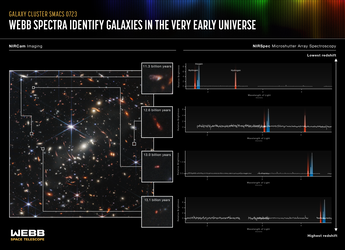

Webb spectrum showcases galaxy’s composition
This galaxy emitted its light 13.1 billion years ago.
It was captured by Webb’s microshutter array, part of its Near-Infrared Spectrograph (NIRSpec). This instrument is so sensitive that it can observe the light of individual galaxies that existed in the very early Universe. This will prove transformational for research. Webb’s capabilities have allowed scientists to observe spectra of galaxies this far away for the first time.
When researchers stretch out the light of an individual galaxy into a spectrum, like the graph shown above, they can learn about the chemical composition, temperature, and density of the galaxy’s ionized gas. For example, this galaxy’s spectrum will reveal the properties of its gas, which will indicate how its stars are forming and how much dust it contains. These data are rich – and have never before been detected from this far away at this quality.
As astronomers begin analyzing Webb’s data, we will learn an incredible amount about galaxies that existed all across cosmic time – and how they compare to the beautiful spiral and elliptical galaxies in the nearby Universe.
Want to capture your own spectra with Webb’s microshutter array? Learn how scientists use the instrument by “taking” your own observations in this interactive and analyze the spectra it returns.
NIRSpec was built for the European Space Agency (ESA) by a consortium of European companies led by Airbus Defence and Space (ADS) with NASA’s Goddard Space Flight Center providing its detector and micro-shutter subsystems.





